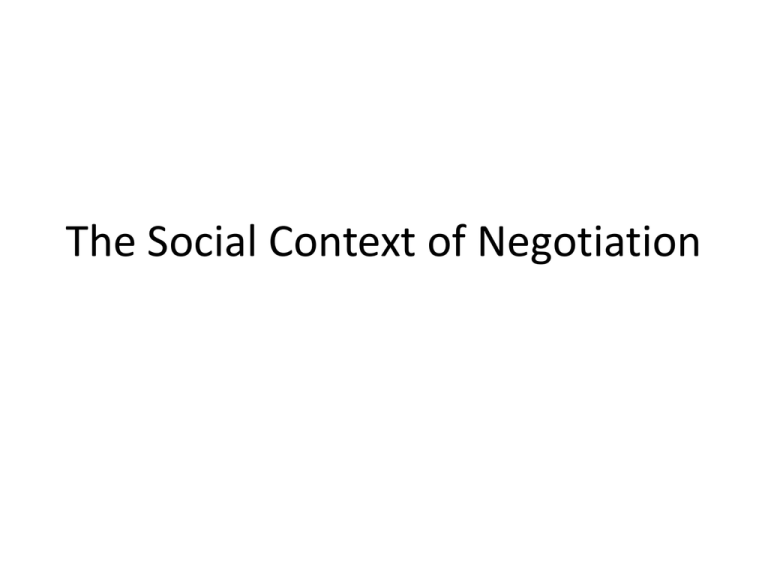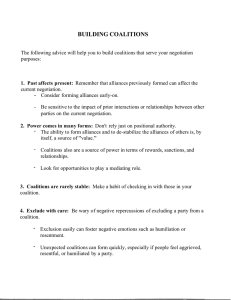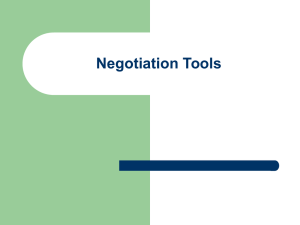The Social Context of Negotiation
advertisement

The Social Context of Negotiation No. of parties in a negotiation • • • • • • Negotiating Dyad Agents and constituencies Additional negotiators Negotiating teams Unrepresented bystanders and audiences Third parties Negotiating within a relationship • Negotiating within relationships takes place over time • Negotiation is often not a way to discuss an issue but to learn more about each other and increase interdependence • Resolution of simple distributive issues has implications for the future • Distributive issues within relationships can be emotionally hot • Negotiating within relationships may never end • In many negotiations, the ‘other person’ is the problem • In some negotiations relationship preservation is the negotiation goal Key dimensions of relationships • • • • Attraction Rapport Bonding Breadth Attraction • Affect : liking the other person • Stimulation: experiencing the other as intellectually challenging • Commonality: sharing things in common • Romantic interest: being physically attracted to the other Rapport • Trust: reliability, interpersonal integrity, altruism • Disclosure: openness with which the parties deal with each other • Empathy : ability to see it from the other’s point of view • Acceptance: unconditional positive regard for the other • Respect: a view of the other possessing a strong value system and being committed to it Bonding • Alliance: a feeling of being ‘on the same side’ • Exchange: tangible benefits which they derive from being associated with each other • Cooperation: degree to which both parties are able to work in unison to achieve respective goals Breadth of relationship • Scope of the relationship: how large the the domain of relationship is • Time horizon: how long the period of association has been Key elements in managing negotiations within relationships • Trust – calculus based, knowledge based, identification based • Emotions – positive, negative • Justice – distributive, procedural, interactive Trust Agreement Matrix High Agreement Bedfellows Allies Fence Sitters Adversaries Opponents Low Low Trust High When coalitions are formed, they could be • Allies – who are in agreement with a negotiator’s goals and vision and whom the negotiator trusts. • Opponents – people with whom the negotiator has conflicting goals and objectives, but who can be trusted to be principled and candid in their opposition • Bedfellows – people with whom a negotiator has high agreement on objectives but with low to moderate levels of trust • Fence sitters – parties who will not take a stand, one way or the other • Adversaries – low in agreement, low on trust Action strategy for building relationships in coalitions With allies • Affirm your agreement on the collective vision or objective • Reaffirm the quality of relationship • Acknowledge the doubt and vulnerability that you have with respect to achieving your vision and collective goal • Ask for advice and support Action strategy for building relationships in coalitions With opponents • Reaffirm that your relationship is based on trust • State your vision or position • State in a neutral way what you think their position or vision is • Engage in some kind of problem solving Action strategy for building relationships with coalitions With bedfellows • Reaffirm the agreement • Acknowledge the caution that exists • Be clear about what you want from bedfellows in terms of their support • Ask bedfellows what they want from you • Try to reach an agreement on how to work together Action strategy for building relationships in coalitions With fence sitters • Stae your position on the project • Ask where they stand • Apply gentle pressures • Encourage them to think about the issue and tell you what it would take to get their support Action strategy to building relationships in coalitions With adversaries • State your visions and goals • State in a neutral way your understanding of your adversary’s position • Identify your own contribution to the poor relationship between you and your adversary • End the meeting by restating your plan but making no demands











